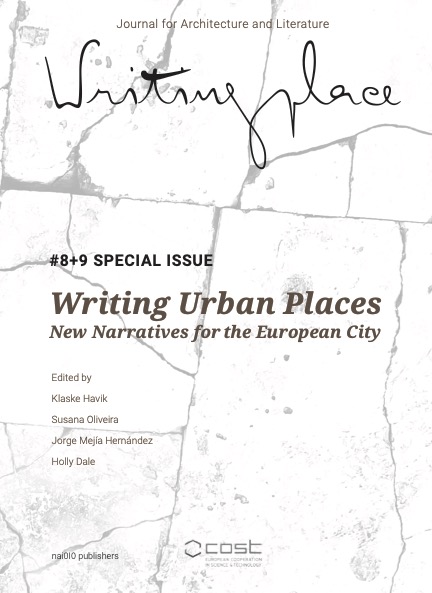Tampere
Co-Constructed Narratives of the Grassroots in the City Narrating Hiedanranta
DOI:
https://doi.org/10.7480/writingplace.8-9.7257Abstract
Hiedanranta is a former industrial complex located on the shores of lake Näsijärvi in Tampere, the second largest city in Finland. Currently, the area is inhabited by diverse cultural actors that work on individual as well as collective projects and who have also appropriated the buildings and surrounding areas, physically transformed them and provided them with new uses, while unleashing other, often political, processes. It is the work of these actors on the territory that renders this site’s special, haptic and creative character. Notwithstanding, the area is currently undergoing a dramatic transformation. Due to a large urban development project, the material substrate of the site as well as its internal social dynamics are rapidly changing, already seeing some cultural groups being permanently displaced. It is within this context that the COST Action team in Tampere organized a workshop to gather, understand and retell the stories of different cultural actors working on the site by employing different participatory visual and narrative methods.
In this contribution, we explore Hiedanranta through six co-constructed narratives. These narratives bring together visual material and poetic practices as well as long narrations of personal experience that shed light on the lives of these cultural actors as they unfold in and relate to Hiedanranta. By bringing these narratives to the fore, we aim to challenge objectivist and positivist forms of generating knowledge about urban places by taking narratives of personal experiences as legitimate sources of knowledge seriously, recognizing that knowledge is both situated and subjective; to deploy co-constructed narratives of a site as a form of subjective representation of a place that counters abstract representations of space; to illustrate the way in which the grassroots are also shaping plans, policies and spaces and therefore should find a place in theoretical planning discourses. Most importantly, through these narratives we hope to keep the stories of Hiedanranta alive before, like the old factory buildings, these are forever erased.
References
Elina Alatalo et al., ‘Co-designing Workshops of Hiedanranta: Vision of Dwellers’, in: University of Tampere (Tampere, 2018).
Elina Alatalo et al., ‘Heating up the Sauna: Analogue Model Unravelling the Creativity of Public Participation’, Planning Theory (March 2023).
Cecile Badenhorst et al., Re-imagining Doctoral Writing (Colorado: University Press of Colorado, 2021).
Pamela Burnard et al., Doing Rebellious Research: In and Beyond the Academia (Leiden: Brill, 2022).
Niel Brenner, Peter Marcuse and Margit Mayer, Cities for People Not for Profit: Critical Urban Theory and the Right to the City (London: Routledge, 2012).
Manuel Castells, The City and the Grassroots: A Cross-cultural Theory of Urban Social Movements (London: Arnold, 1983).
Donna Haraway, ‘Situated Knowledges: The Science Question in Feminism and the Privilege of Partial Perspective’, Feminist Studies 14 (1988), 575-599.
Klaske Havik and Alberto Arlandis, ‘Choreography as a Tool to Understand Architectural Situatedness: A Mediating Intervention at Hiedanranta Industrial Heritage Ste, Finland’, Journal of Architecture 27:4 (2022): 539-557.
Jeremy Allan Hawkins, ‘From Narrative Object to Poetic Practices: On Figurative Modes of Urbanism’, Urban Planning 7 (2022), 430-439.
James Holston, ‘Spaces of Insurgent Citizenship’, Planning Theory 13 (1995), 35-51.
Efadul Huq, ‘Seeing the Insurgent in Transformative Planning Practices’, Planning Theory 19 (2020).
Kirsi Pauliina Kalio et al., ‘Skatescape in the Making: Developing Sustainable Urban Pedagogies through Transdisciplinary Education’, Sustainability 13 (2021).
Jeong-hee Kim, Understanding Narrative Inquiry: The Crafting and Analysis of Stories as Research (Thousand Oaks, CA: SAGE, 2015).
Marcelo Lopes de Souza, ‘Lessons from Praxis: Autonomy and Spatiality in Contemporary Latin American Social Movements’, Antipode 48 (2016), 1292-1316.
Carlos Machado e Moura et al. (eds.), REPOSITORY: 49 Methods and Assignments for Writing Urban Places (Rotterdam: nai010, 2023)
Dalia Milián Bernal, ‘Challenging Methodologies: Deploying Liberatory Epistemologies to Unlock Creative Research Practices’, Qualitative Research (forthcoming).
Walter Mignolo, ‘Epistemic Disobedience and the Decolonial Option: A Manifesto’, TRANSMODERNITY: Journal of Peripheral Cultural Production of the Luso-Hispanic World 1 (2011), 3-23.
Faranak Miraftab, ‘Insurgent Planning: Situating Radical Planning in the Global South’, Planning Theory 8 (2009), 32-50.
Luc Pauwels, ‘Conceptualizing the “Visual Essay” as a Way of Generating and Imparting Sociological Insight: Issues, Formats and Realisations’, Sociological Research Online 17 (2012), 76-86.
Luc Pauwels, Reframing Visual Social Science: Towards a More Visual Sociology and Anthropology (Cambridge: Cambridge University Press, 2015).
Leonie Sandercock, Making the Invisible Visible: A Multicultural Planning History (Berkeley: University of California Press, 1998).
Jonas Sjöblom et al., ‘Crafting a Planning Issue with Citizens in the Context of Planning Competition: A Case of “Nordic Superblock”’, Journal of Urban Design 26 (2021).
Veera Turku, Ari Jokinen and Pekka Jokinen, ‘How Do Time-Bound Practices Initiate Local Sustainability Pathways?’, Sustainable Cities and Society 79 (2022).
Veera Turku et al., ‘Exploring the Catalytic Power of Temporary Urbanism through a Binary Approach’, Cities 133 (2023).
Downloads
Published
Issue
Section
License
Copyright (c) 2023 Dalia Milián Bernal, Elina Alatalo, Jeremy Allan Hawkins, Panu Lehtovuori

This work is licensed under a Creative Commons Attribution 4.0 International License.


